This article needs additional citations for verification .(January 2022) |
The years leading up to World War II (and during the conflict) saw great changes in the sexual habits of European societies.
This article needs additional citations for verification .(January 2022) |
The years leading up to World War II (and during the conflict) saw great changes in the sexual habits of European societies.

In the occupation years, as the French dealt with their humiliating defeat and surrender, the morality of sex in Vichy France changed. In his book 1940–1945, The Erotic Years: Vichy, or, the Misfortunes of Virtue, Patrick Buisson talks about "erotic shock ... or exploring new territories of pleasure." [1] The sexual virility of German troops became legendary within France, and as a result of such psychological trauma, France became personified as a 'female' country. [1] Local cinemas and even subway stations became locations for anonymous physical trysts during Allied bombings. [2] After Allied liberation, anyone who had a reputation for associating with the Germans were targeted as collaborators, and faced hazing or worse.
Within Germany in the 1930s, many German Protestants and German Catholics shared the view that Jewish people were responsible for the sexual immorality that pervaded Weimar Culture. Many church leaders supported the Nazis, welcoming radical measures against "public immorality" that included shutting down brothels, gay and lesbian bars, and nudist organizations. [3] The initial support of the Nazi leadership from both Catholic and Protestant churches was based on the belief that the Nazis would purify German sexual mores, and reinstitute respect for family values. [3]
In the early 1900s, Germany, and particularly Berlin, had developed a reputation for relaxed sexual mores. As Dagmar Herzog writes in Sexuality In Europe: A Twentieth Century History, “There was more detailed discussion of the best techniques for enhancing female orgasm under Nazism than there would be in the far more conservative decade of the 1950s.” [4] The flip-side to liberalization for some was crackdowns on others. [4] By the 1930s, the Nazi leadership was increasingly anxious about being perceived as “queer”. [5] In 1934, Adolf Hitler facilitated the murder of Ernst Röhm, his openly gay friend and leader of the Sturmabteilung (SA) paramilitary wing of the Nazi Party. Until then, many bars frequented by members of the SA were well known as gay establishments, and there was no perceived tension between activism for greater rights for homosexuals and right-wing politics. [5] The prevalence of same-sex institutions like the Hitler Youth and the League of German Girls fostered suspicions of homoeroticism, and subsequently the regime tried to prove its straightness. All of that would change when the virulently homophobic Heinrich Himmler became one of the most powerful people in the Third Reich. [5] In 1935, Germany strengthened laws that criminalized male (but not female) homosexuality. Not only mutual masturbation but parallel individual masturbation, and even “erotic” glances fell under the purview of such anti-gay laws. [5] Penalties for homosexual behavior escalated considerably by 1937, and by the end of the War, around 100,000 men had been prosecuted for same-sex behavior. Close to half had been convicted, sent to labor camps, prisons, or penitentiaries, subjected to medical experiments, or forced to have sex with female prostitutes. [6] Many Jewish people who were held captive would face a similar fate. [7]
The association between sex, homosexuality, and Jewish people was supported by Catholic and Protestant church leaders and ultimately the Nazi regime. [3] While not all activists who fought for the legalization of abortion and homosexuality were Jewish, many were, and their leadership in these movements made them easy targets of religious vitriol which Nazism exploited. [7] Sexual innuendo was a vital component of Nazi anti-Semitism, exploiting sentiments that readily associated Jewish people with sex. [7]
The reorganization of sexuality was at the heart of the Nazi project. It would be a mischaracterization, however, to declare that the Third Reich was repressive for everyone. For those who did not fall prey to its animus, the Nazi regime's overall goal was not to suppress sexuality, but to foster it as a distinctly Aryan privilege. [8] While structural racism of any kind has always necessarily depended on controlling reproduction, this was especially true of the Third Reich. Restrictions on contraception and abortion coaxed the reproduction of those deemed “healthy” to perpetuate the Volk , or race, who were ushered along through financial incentives and propagandistic enticements, while those deemed unfit to reproduce were prohibited from doing so with sterilization, involuntary abortion, and mass murder. [8] By the early 1940s, it was no secret that the regime was openly encouraging extramarital sex and infidelity, endorsing it not only as a reproductive measure, but also as a pleasurable pursuit reserved for the racially pure. [4] Abortions were denied to the majority of German women, while coercive abortions were violently imposed on Roma and Jewish women. Nazi sexual politics harnessed two competing tendencies, playing into either when politically expedient: conservative currents of consternation and concern with sex on the one hand, and the greater historical trend of liberalization of heterosexual norms on the other, in order to execute a viciously homophobic and racist agenda. [8]
The German birth rate, like that in most industrial nations, had been falling for decades prior. When Hitler and the Nazi Party took power in 1933 they implemented several revolutionary policies in order to change the sexual practices of the German people and reverse this slide in birth rates. At the same time that it forbade the mixing of Jews and Germans through the Nuremberg Laws, the Nazi government tried a number of policies designed to increase new births. One was to change marriage laws via the 1938 divorce-reform law by the Minister of Justice, Franz Gürtner. [9] Within two years, 30,000 divorces were filed, 80% of which were husbands casting off women over 45 years old. [10] While the new law increased new marriages and children from these marriages, the Nazis looked to illegitimate births in Germany as a way to increase the country’s birthrate. [10]
In the 1920s, there were about 150,000 illegitimate births in Germany, before halving during the Great Depression and rebounding to 100,000 in 1935. [10] The Nazis wanted to increase illegitimate births by encouraging out-of-wedlock births, especially those of Aryan parentage. Part official policy, part propaganda, the Nazi measure manifested itself in the Lebensborn program. The Lebensborn program gave a place where unmarried women could give birth in secret. [11]

Only the “purest” of applicants were chosen to join such programs, and only 40% passed the racial purity test (wherein they had to show their family tree three generations back), and were granted admission into the program. The majority of mothers were unmarried, 57.6% until 1939, and about 70% by 1940. [12]
The Lebensborn program was given a further push when Himmler issued a proclamation that every SS soldier should father a child before he left for war, and the child could then be born and raised at Lebensborn facilities. [13] Through these policies the birthrate increased, and Himmler told his doctor Felix Kersten how proud he was to have a role in the change, “Only a few years ago illegitimate children were considered a shameful matter ... [now] my men tell me with shining eyes that a son has been born to them. Their girls consider it an honour, not a source of shame.”
Once World War II broke out, and men were sent to the front, the Nazis changed their promise of “every woman will have a man” to “every woman will have a child”. A 1944 report to the Ministry of Justice stated that:
Leaders of the [League of German Girls have] intimated to their girls that they should bear illegitimate children; these leaders have pointed out that in view of the prevailing shortage of men, not every girl could expect to get a husband in future, and that the girls should at least fulfill their task as German women and donate a child to the Führer. [14]
Had the Germans triumphed, Himmler with Nazi Party Chancellery head and Hitler’s personal secretary to Martin Bormann were considering a post-War institution of double marriage for Nazi party officials and war heroes. [15]

Sexology is the scientific study of human sexuality, including human sexual interests, behaviors, and functions. The term sexology does not generally refer to the non-scientific study of sexuality, such as social criticism.

Before 1933, male homosexual acts were illegal in Germany under Paragraph 175 of the German Criminal Code. The law was not consistently enforced, however, and a thriving gay culture existed in major German cities. After the Nazi takeover in 1933, the first homosexual movement's infrastructure of clubs, organizations, and publications was shut down. After the Röhm purge in 1934, persecuting homosexuals became a priority of the Nazi police state. A 1935 revision of Paragraph 175 made it easier to bring criminal charges for homosexual acts, leading to a large increase in arrests and convictions. Persecution peaked in the years prior to World War II and was extended to areas annexed by Germany, including Austria, the Czech lands, and Alsace–Lorraine.

Magnus Hirschfeld was a Jewish German physician and sexologist, whose citizenship was later revoked by the Nazi government. Hirschfeld was educated in philosophy, philology and medicine. An outspoken advocate for sexual minorities, Hirschfeld founded the Scientific-Humanitarian Committee and World League for Sexual Reform. He based his practice in Berlin-Charlottenburg during the Weimar period. Performance Studies and Rhetoric Professor Dustin Goltz characterized the committee as having carried out "the first advocacy for homosexual and transgender rights".
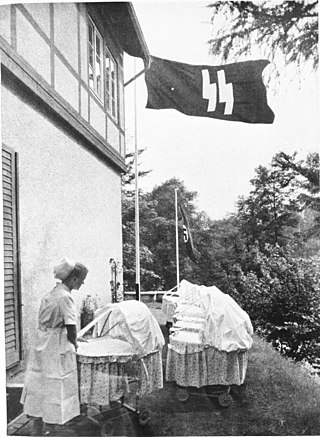
Lebensborn e.V. was a secret, SS-initiated, state-registered association in Nazi Germany with the stated goal of increasing the number of children born who met the Nazi standards of "racially pure" and "healthy" Aryans, based on Nazi eugenics. Lebensborn was established by Heinrich Himmler, and provided welfare to its mostly unmarried mothers, encouraged anonymous births by unmarried women at their maternity homes, and mediated adoption of children by likewise "racially pure" and "healthy" parents, particularly SS members and their families. The Cross of Honour of the German Mother was given to the women who bore the most Aryan children. Abortion was legalized by the Nazis for disabled and non-Germanic children, but strictly punished otherwise.
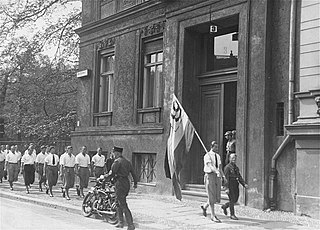
The Institut für Sexualwissenschaft was an early private sexology research institute in Germany from 1919 to 1933. The name is variously translated as Institute for Sexual Research, Institute of Sexology, Institute for Sexology, or Institute for the Science of Sexuality. The Institute was a non-profit foundation situated in Tiergarten, Berlin. It was the first sexology research center in the world.
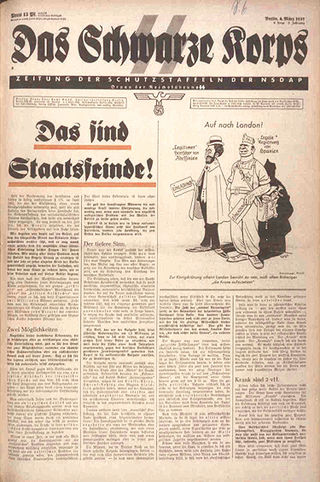
Das Schwarze Korps was the official newspaper of the Schutzstaffel (SS). This newspaper was published on Wednesdays and distributed free of charge. All SS members were encouraged to read it. The chief editor was SS leader Gunter d'Alquen; the publisher was Max Amann of the Franz-Eher-Verlag publishing company. The paper was hostile to many groups, with frequent articles condemning the Catholic Church, Jews, Communism, Freemasonry, and others.

Blood and soil is a nationalist slogan expressing Nazi Germany's ideal of a racially defined national body ("Blood") united with a settlement area ("Soil"). By it, rural and farm life forms are idealized as a counterweight to urban ones. It is tied to the contemporaneous German concept of Lebensraum, the belief that the German people were to expand into Eastern Europe, conquering and displacing the native Slavic and Baltic population via Generalplan Ost.
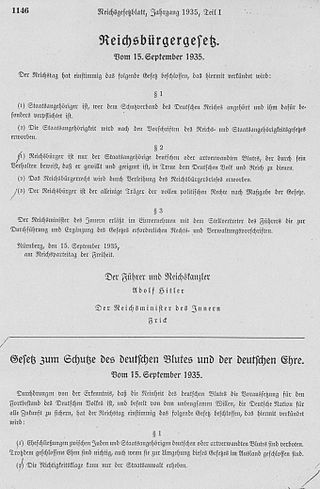
Rassenschande or Blutschande was an anti-miscegenation concept in Nazi German racial policy, pertaining to sexual relations between Aryans and non-Aryans. It was put into practice by policies like the Aryan certificate requirement, and later by anti-miscegenation laws such as the Nuremberg Laws, adopted unanimously by the Reichstag on 15 September 1935. Initially, these laws referred predominantly to relations between ethnic Germans and non-Aryans, regardless of citizenship. In the early stages the culprits were targeted informally; later, they were punished systematically and legally.

The Pink Swastika: Homosexuality in the Nazi Party is a 1995 pseudohistorical book by Scott Lively and Kevin Abrams. Drawing on Samuel Igra's 1945 book Germany's National Vice, Lively and Abrams argue that the crimes committed by homosexuals in the Nazi Party exceed the persecution of homosexuals in Nazi Germany and that homosexuality contributed to the extreme militarism of Nazi Germany. They contend that only feminine homosexuals were persecuted by the Nazis, while "butch" homosexuals formed the leadership cadre of the Nazi party. Historian Andrew Wackerfuss criticized the book for lack of accuracy and "outright homophobic charges". The claim advanced by Igra, Lively, and Abrams that homosexuals were responsible for Nazi atrocities is rejected by most historians.

The social policies of eugenics in Nazi Germany were composed of various ideas about genetics. The racial ideology of Nazism placed the biological improvement of the German people by selective breeding of "Nordic" or "Aryan" traits at its center. These policies were used to justify the involuntary sterilization and mass-murder of those deemed "undesirable".
Holocaust victims were people targeted by the government of Nazi Germany based on their ethnicity, religion, political beliefs, disability or sexual orientation. The institutionalized practice by the Nazis of singling out and persecuting people resulted in the Holocaust, which began with legalized social discrimination against specific groups, involuntary hospitalization, euthanasia, and forced sterilization of persons considered physically or mentally unfit for society. The vast majority of the Nazi regime's victims were Jews, Sinti-Roma peoples, and Slavs but victims also encompassed people identified as social outsiders in the Nazi worldview, such as homosexuals, and political enemies. Nazi persecution escalated during World War II and included: non-judicial incarceration, confiscation of property, forced labor, sexual slavery, death through overwork, human experimentation, undernourishment, and execution through a variety of methods. For specified groups like the Jews, genocide was the Nazis' primary goal.
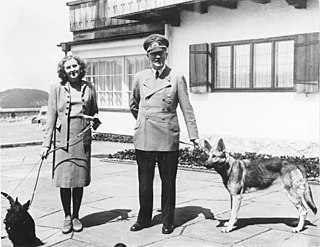
The sexuality of Adolf Hitler, dictator of Germany from 1933 to 1945, has long been a matter of historical and scholarly debate, as well as speculation and rumour. There is evidence that he had relationships with a number of women during his lifetime, as well as evidence of his antipathy to homosexuality, and no evidence of homosexual encounters. His name has been linked to a number of possible female lovers, two of whom committed suicide. A third died of complications eight years after a suicide attempt, and a fourth also attempted suicide.

Ostarbeiter was a Nazi German designation for foreign slave workers gathered from occupied Central and Eastern Europe to perform forced labor in Germany during World War II. The Germans started deporting civilians at the beginning of the war and began doing so at unprecedented levels following Operation Barbarossa in 1941. They apprehended Ostarbeiter from the newly-formed German districts of Reichskommissariat Ukraine, District of Galicia, and Reichskommissariat Ostland. These areas comprised German-occupied Poland and the conquered territories of the Soviet Union. According to Pavel Polian, although the Ostarbeiter from most occupied territories were predominantly men, of the "eastern workers" taken from occupied Soviet territories over 50% were women, and of those from Poland nearly 30% were women. Eastern workers included ethnic Ukrainians, Poles, Belarusians, Russians, Armenians, Tatars, and others. Estimates of the number of Ostarbeiter range between 3 million and 5.5 million.
Nazism ( NA T-siz-əm; formally National Socialism, is the far-right totalitarian socio-political ideology and practices associated with Adolf Hitler and the Nazi Party in Germany. During Hitler's rise to power in 1930s Europe, it was frequently referred to as Hitlerism. The later related term "neo-Nazism" is applied to other far-right groups with similar ideas which formed after the Second World War when the Third Reich collapsed.

Women in Nazi Germany were subject to doctrines of Nazism by the Nazi Party (NSDAP), which promoted exclusion of women from the political and academic life of Germany as well as its executive body and executive committees. On the other hand, whether through sheer numbers, lack of local organization, or both, many German women did indeed become Nazi Party members. In spite of this, the Nazi regime officially encouraged and pressured women to fill the roles of mother and wife only. Women were excluded from all other positions of responsibility, including political and academic spheres.

The ideology of the Schutzstaffel, a paramilitary force and an instrument of terror of the Nazi Party in Nazi Germany, emphasized a racist vision of "racial purity", primarily based on antisemitism and loyalty to Adolf Hitler and Nazi Germany.
Carl-Heinz Rodenberg, sometimes known as Karl-Heinz Rodenberg was a German neurologist and psychiatrist. Rodenberg was proficient in the murder of mental patients by the Nazis, the Action T4 "euthanasia" program, and from 1943 was scientific director of the Reich Central Office for the Combating of Homosexuality and Abortion.

Capital punishment as a criminal punishment for homosexuality has been implemented by a number of countries in their history. It is a legal punishment in several countries and regions, all of which have sharia–based criminal laws, except for Uganda.
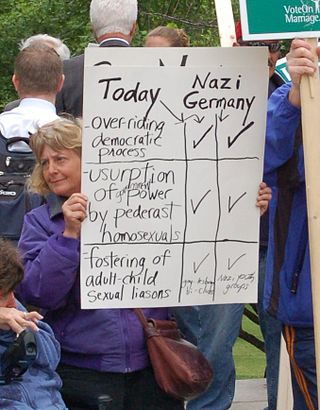
There is a widespread and long-lasting myth alleging that homosexuals were numerous and prominent as a group in the Nazi Party or the identification of Nazism with homosexuality more generally. It has been promoted by various individuals and groups from before World War II through the present, especially by left-wing Germans during the Nazi era and the Christian right in the United States more recently. Although some gay men joined the Nazi Party, there is no evidence that they were overrepresented. The Nazis harshly criticized homosexuality and severely persecuted gay men, going as far as murdering them en masse. Therefore, historians regard the myth as having no merit.

The Röhm scandal resulted from the public disclosure of Nazi politician Ernst Röhm's homosexuality by anti-Nazis in 1931 and 1932. As a result of the scandal, Röhm became the first known homosexual politician.